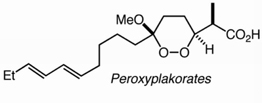Department of Chemistry
Document Type
Article
Date of this Version
February 2006
Abstract
Fumonisins are a group of polyketide-derived mycotoxins produced by Fusarium Verticillioides, a filamentous fungus infecting corn and contaminating food and feeds. Fumonisins contain two tricarballylic esters that are critical for toxicity. Here, we present genetic and biochemical data for the esterification mechanism. FUM14 in F. Verticillioides has been deleted by homologous recombination, and the resultant mutant lost the ability to produce fumonisins. Two new metabolites, HFB3 and HFB4, which are biosynthetic precursors of fumonisins lacking the tricarballylic esters, were detected in the mutant. The results suggest that FUM14 is required for the esterification of fumonisins. FUM14 was predicted to encode a nonribosomal peptide synthetase (NRPS) containing two domains, peptidyl carrier protein and condensation domain. Both the intact Fum14p and the condensation domain have been expressed in Escherichia coli and purified for activity assays. Fum14p was able to convert HFB3 and HFB4 to the tricarballylic esters-containing fumonisins, FB3 and FB4, respectively, when incubated with tricarballylic thioester of N-acetylcysteamine. In addition, the condensation domain was able to convert HFB1 to FB1. These data provide direct evidence for the role of Fum14p in the esterification of fumonisins. More interestingly, the results are the first example of an NRPS condensation domain catalyzing a C-O bond (ester) formation, instead of the typical C-N bond (amide) formation in nonribosomal peptides. The understanding of the esterification mechanism provides useful knowledge for mycotoxin reduction and elimination. The study also provides new insight into the reactions catalyzed by NRPS.



Comments
Published in Biochemistry 2006, 45, 2561-2569.